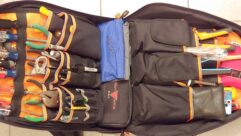Keys to Security
Jan 1, 2002 12:00 PM,
By Steve Filippini
Recent events have increased our overall awareness; personal protection and peace of mind can no longer be taken for granted. We have to take a fresh look at our surroundings and strengthen any security weakness that may be there. We need to look closely both at our homes and our businesses in this regard.
ON THE HOME FRONT
Our home is indeed our castle. It is the one place we can retreat from the world and keep at bay those elements that interfere with our happiness. I have talked about standard fire and security systems in the past, and it is now time we took it up a notch.
The Standard Home System
As you probably already know, a basic security system includes an intelligent control panel with a user keypad. The keypad is used to transmit the homeowner’s needs and intentions directly into the system’s microprocessor for immediate response. It also serves as the eyes into the system: Status messages and indications alert the user to the current conditions the system is reacting to. When it beeps or chirps, you take notice to see what the system is trying to communicate.
The perimeter of a home is usually protected through a series of electronic sensors and contacts that relay the status of doors and windows to the main control panel. A violation of a protected opening will result in an alarm or trouble condition depending on the programming and design of the system. The interior of the home is typically covered with motion detectors and infrared sensing devices. The body temperature (infrared radiation) of someone walking in front of the beam will differ from its environment. This will trip the sensor and cause a reaction in the system. The interior devices are there to back up the perimeter devices. If an intruder manages to get past these first two lines of defense, the homeowner can activate a panic button to alert the neighbors and authorities that something is wrong. A nearby baseball bat can also come in handy if the need arises; but, hopefully, it will never come to that.
Speaking of alerting the neighbors, it’s wise to have a large siren at your disposal. The only requirement when using a siren is to have an unobstructed location where it can be directed at your nearest neighbor or local gathering area. Special care should be taken to avoid repeated false alarms, though. Crying wolf will mean your real emergency is likely to be ignored, and meanwhile, you may get angry messages scrawled on your garage door and car. Trust me on this one.
Beyond the Basics
Now you need to start thinking outside of the box. What can you do to increase the level of security beyond taking the steps already discussed? You can start by including an intercom system. These devices, when properly located, can be your extra set of ears. You can locate someone in another room or part of the home without running around and looking for them. If there was ever a benefit to an intercom system, it’s that it can cut down on the yelling that usually takes place in a family dwelling.
But there are security uses on top of this. Intercoms include a standard feature that allows you to leave a remote station activated for listening purposes. The master station should be located in the master bedroom and/or gathering space. Some systems even allow multiple master stations without sacrificing features and functions. With these devices in place, you can remotely (and safely) listen for anything out of place when your security system alerts you to a possible situation that may require you to act. Some intercom systems have remote camera and monitoring stations as well. My favorite is the video station designed to be located outside your front door. Anyone wishing to gain access into your home has to press a call button. You can then view the visitor and determine whether they are welcome.
Large homes and estates even have intercoms located at security gates. No entry onto the property is allowed until the homeowner presses the access button to remotely open the gate. Granting access from a safe distance is always preferred. As far as what vendor to use, it’s all up to your taste and comfort level. Personally, Aiphone has always met my needs at home and in the field.
Another line of defense takes place outside of the home. Gates and walls are nice, but they are not totally effective. So if you are not planning on digging a respectable moat around the property or gracing your walls with razor wire, you may want to look into some outside beams and sensors. Don’t try to use the standard infrared motion sensors for this application unless you plan to monitor the nocturnal activities of the critters that live out there. One method that has worked well for me is double-stacked photoelectric cells. PECs are usually installed at each corner of the yard and form a box of protection around the home when armed.
A PEC consists of a transmitter and a receiver. The transmitter is installed at one corner and the receiver is placed directly in line at the other corner. When a photoelectric beam is transmitted and received correctly, the security system is happy. When a solid mass steps between the two components, the beams are interrupted and the alarm will sound. I always recommend the double-stacked models to reduce false alarms from active critters, low swooping birds and blowing leaves that visit your yard on a nightly basis. The double-stacked PEC has two sets of transmitters and receivers. Standard models even have a feature that will compensate for fog and heavy rain to avoid false-alarm activation. If this does not sound like something you would want to invest in, large, hungry dogs are just as effective. Maybe even more so.
Closing out the residential side, keep in mind that security systems are a great addition to homes, serving as deterrents and giving you the upper hand in case of intrusion — but the physical make-up of the home is just as important and also needs to be addressed. Heavy doors, quality locks and deadbolts are worth the investment. Peep-holes in the front door are not as slick as electronic cameras and monitors, but they can be just as effective. Close your drapes and curtains at night to ensure your privacy and stop unwanted onlookers from following your movement throughout the home. Locking the doors and windows before retiring for the evening should be a nightly routine. Be aware of your surroundings to avoid surprises.
PROTECTING YOUR WORKPLACE
On the commercial side of the security business, the opportunity for system enhancement is larger than when dealing with a home. One reason for this is no one wants to live in an environment that resembles a steel fortress. The home needs to look comfortable and feel warm. Business owners, on the other hand, demand something as close to Fort Knox as possible, and rightly so.
Magnetic Locks/Doorstrikes
Again, we should start with the perimeter protection. Warehouse doors at an employee entrance are typically made out of heavy metal that will withstand economy-sized battering rams. The standard lock-and-deadbolt configuration works, but the overall level of security can be improved. Installing magnetic door locks and doorstrikes increases the owner’s ability to limit an individual’s entrance into a building. A magnetic lock (or mag-lock) is made up of a large electromagnet mounted on the top of a doorframe and a flat, metal plate mounted on the access door. Low-voltage power is supplied to the mag-lock, and an electromagnetic field pulls the plate in and holds it in place. Depending on the model used, a mag-lock can withstand up to 1200 pounds of pressure without releasing the door.
A doorstrike, on the other hand, is located in the side doorjamb and holds the door’s catch/deadbolt component in place. Turning the doorknob should not retract the bolt, so the release must come from the doorstrike. The doorstrike is made up of a small electromagnet that retracts the catch from a deadbolt to allow the door to be opened when pulled. You know when the door is granting access by either the unmistakable buzzing sound that emits from the frame or a distinct “clack” that indicates the strike has been retracted. The former type of doorstrikes — the ones that buzz — do so because the strike is only energized when voltage is present. When activated, this creates the buzzing sound from the frame. If you lose power to the doorstrike, you cannot open the door without a key. The “clack” type has the strike constantly energized. When activated, the sound is made as the strike is de-energized and retracts. If you lose power to this style of doorstrike, the door is unsecured, and unlimited access is granted.
Both mag-locks and doorstrikes use an electromagnet, but power to these locks may be supplied differently. A mag-lock relies on a constant voltage source to energize the magnetic coil to keep the door’s metal plate secured. Removing the voltage will collapse the magnetic field and allow access. The doorstrike (depending on the style) is constantly set in a locked position and releases the catch when power is either supplied or removed. Both of these locks also have optional battery backup applications that will grant access and maintain control in the event of a power failure.
Since controlling the voltage source that feeds these types of locks is necessary, choosing the correct form of control is the next priority. The most common method used in a front-lobby setting is to place a momentary push-button switch at the receptionist’s desk. When the button is pressed (depending on its normally open or closed wiring configuration) the door is released. This method works, but the receptionists I’ve dealt with over the years get really cranky when you request multiple door releases while completing an extended service call. This crankiness is probably what prompted someone to design the first card-access system.
Card Access
A card-access system is also made up of two components: a card or token reader, mounted next to the controlled door at waist height, and the access cards or tokens themselves. There are many card-access systems out on the market, but they all do the same thing. The differences lie in how they read the card or token to establish authorized access. Proximity readers rely on a wireless design. This reader is usually black in color and can be anywhere from 2 to 4 inches in height and width. When power is supplied to the proximity reader, an antenna in the reader emits a continuous low-frequency RF field. When an authorized card or token is presented to the reader (sometimes up to 4 inches away), an antenna in the card/token gathers energy from the RF field. This energy enables the internal circuitry of the card, which, in turn, transmits a unique identification number back to the reader. The reader’s job is to decode and verify the validity of the signal. A valid signal is transmitted back to the card-access control panel through data cables. The card-access control panel reacts to the card/token that was presented and carries out a predetermined action (e.g., it lets the validated visitor enter).
The second type of reader has many names, but I mostly hear it referred to as a swipe reader. This reader is also mounted next to the access-controlled door and is usually 1 to 2 inches wide and 4 to 6 inches high with a 1-inch groove running the length of the reader. The access card for this type of reader resembles a credit card complete with a magnetic strip running along the back of the card. To request access, the user swipes the card through the reader, which is reading the information imbedded in the magnetic strip. Again, the valid signal is transmitted back to the access control panel through data cables for processing.
Both types of readers are reliable, but there are some features and limitations with each one. The swipe reader is designed to be weatherproof but does not handle moisture on the swipe contacts well. If there is any film or moisture on the swipe contacts, access is difficult to achieve. The access cards tend to break or crack easily if handled carelessly. Furthermore, the magnetic strip on the back of the card will eventually wear down due to the physical connection required for reading the unique identification number.
The proximity reader, on the other hand, is weatherproof and does not require a physical connection with the card or token for decoding purposes. The card/token is usually sturdier and does not readily break or crack. Many people place them on their key rings or in their wallets and only need to get close to the reader for access. Other items in a wallet or pocket may interfere with the transmission of the unique identification number, though, and more than one proximity card in your wallet will confuse the reader and not allow access.
Both types of card systems usually require an authorized dealer or specified employee to locally or remotely program the access control panel to accept the unique identification numbers. Most companies will establish a PC for the sole purpose of maintaining an identification database. Since most of the card access systems on the market today can handle well over a thousand unique identification numbers, keeping track of the valid/invalid cards and tokens can be a full-time job.
Security Video
Locating security cameras strategically in and around a business is highly recommended if you happen to have a full-time staff on-site. The industry has recently introduced digital recorders that greatly improve the quality of the images the cameras capture. I highly recommend these. The industry is constantly improving, and you owe it to yourself and your business to keep abreast of the newest technologies available.
Intercom Systems
Although an intercom system is quite effective in a residential application, it is not as effective a tool when you want to listen for a possible intruder inside a commercial business. Commercial sites are full of sounds and noises that seem to multiply and amplify when the sun goes down. Generators, compressors, time clocks (which, when you are alone inside a business at three in the morning, sound like a shotgun round being pumped), plus drafts and frisky critters. This general cacaphony makes it very difficult to pick out and distinguish individual sounds. So instead of focusing on an entire warehouse or manufacturing area, limit your intercom coverage, if you use it, to specific rooms and areas that require special attention and that are otherwise quiet.
The level of protection you select for your home and business is only limited by your ability to look outside of the box and see the entire environment. Carefully examine your home or workplace for weak security spots. If you were a criminal, where would you try to gain access? As a home or business owner, that’s the security area you want to strengthen. Your options are numerous, so shop around and get a system — or combination of systems — that works for you. And don’t delay this project for too long: You know what they say about “a stitch in time.”
On a side note, I was recently asked why I don’t write about car alarms. Car alarms are a distant relative to your standard home or business alarm, and part of a specialized field. I would offer more insight on them, but Daniel Ari beat me to it a few months ago in his “Outside Input” online, and there wasn’t much more I could add to the topic. Maybe next year.
Steve Filippini is a senior security technician with over 20 years of experience in the security installation industry. A regular columnist for S&VC, he can be reached at[email protected].
Tools for Stepping Up Security at Home and at Work
Think Like a Criminal to Conceive the Best Security System
After you’ve decided which system components are right for your home or workplace, the next step is planning. The depth of planning for the job will make the difference between a good installation and a poor one. So where do you begin?
Start at the front door, from the outside. As you walk around the perimeter, identify the different points of entry. Protect all easily accessible windows. Remember to include any basement doors or windows that may be vulnerable to intrusion. Next, focus on the windows that have a roof slant under them. While you are outside, take a minute to determine the best location for an external bell or siren. Position the device to alert any neighbors within earshot. The customer may already have someone in mind for this purpose.
Also look for the telephone service box. In order to provide line-seizure for the security system, you will need to run a 4-conductor cable from the main control panel to the telephone box. If the customer is not going to be monitored by a 24-hour monitoring center, prepare to run the cable anyway. Wire is cheap, labor is expensive, and they may change their mind at a later date.
Interior protection is just as important as the perimeter line of defense. If you are offering infrared motion detectors, you may want to cover open areas that connect one main room to another. Consider stairwells and high-traffic areas. Infrared devices are located on the wall and typically end up in the corner of a room. Protect and cover whatever is important to the customer.
The placement of system keypads is also very important. It can alert customers to intrusion, fires and medical emergencies. It can also provide system status messages. It is best to keep the pad in the room where the customer feels the most comfortable and safe. User keypads should be mounted eye-level and at least 12 inches away from light switches and electrical devices.
Next, choose a location for the main control panel. Locate the control panel centrally to reduce the length of each cable you need to run (utility rooms and unfinished walls or closets are typically chosen in residential installations).
Finally, document where you terminate or hide every wire in the system. Take the time to document correctly, and keep it in a safe place near the job site. It does not make sense to number all of the system’s cables if you cannot find the list that identifies them during the trimming phase.
Now, you are ready to pull out the power tools and begin.










